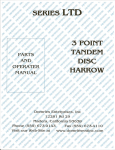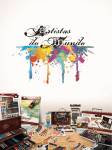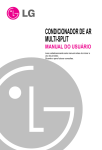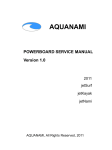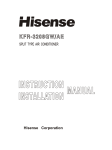Download Sierra 8000TEC Operating instructions
Transcript
Evolution 8000TEC Catalytic Wood Heater Insert Manual Installation & Operating Instructions Please read this entire manual before installation. Save these instructions. This m anual describes the installation, operation and m aintenance of the SIERRA Evolution Model Num ber 8000TEC catalytic wood heater. Please read this entire m anual before you install and use your new room heater. Failure to follow instructions m ay result in property dam age, bodily injury, or even death. Save these instructions for future reference. SAFETY NOTICE If this appliance is not properly installed, a house fire m ay result. For your safety, follow the installation instructions. Check with local building or fire officials about restrictions and installation inspection requirem ents in your area. It is best to have a professional install your Sierra Stove. If you prefer to install it yourself (see Installation Instructions), be sure to obtain the proper perm its. Have the local building officials inspect the stove and chim ney pipe for safety and code com pliance after the installation is com plete. GENERAL INFORMATION W e wish to welcom e you as a new owner of a SIERRA W oodstove. You join m any thousands of happy owners who have been heating with SIERRA stoves since 1972. SIERRA stoves have changed a great deal during that tim e, and all of our knowledge and experience have culm inated in this stove, the SIERRA EVOLUTION. Please read all of this m anual before using your stove, especially if you have owned another woodstove in the past. Failure to follow instructions m ay result in property dam age, bodily injury, or even death. W e at SIERRA wish you m any happy years of warm th and com fort. < < < < SAFETY NOTICE CAUTION: HOT W HILE IN OPERATION. KEEP CHILDREN, CLOTHING AND FURNITURE AW AY. CONTACT M AY CAUSE SKIN BURNS. IF THIS HEATER IS NOT PROPERLY INSTALLED, A HOUSE FIRE M AY RESULT. CONTACT LOCAL BUILDING OFFICIALS ABOUT RESTRICTIONS AND INSTALLATION INSPECTION REQUIREM ENTS IN YOUR AREA. FAILURE TO COM PLY W ITH OW NERS' M ANUAL INSTRUCTIONS W ILL VOID YOUR W ARRANTY! NOT APPROVED FOR M OBILE HOM ES Your SIERRA generates a lot of heat, so treat it with care. Read this m anual thoroughly before installing and operating your stove. THIS STOVE M UST BE CONNECTED TO A LISTED HIGH TEM PERATURE RESIDENTIAL TYPE AND BUILDING AND HEATING APPLIANCE CHIM NEY OR AN APPROVED M ASO NRY CHIM NEY W ITH FLUE LINER. DO NOT CONNECT TO ANY AIR DISTRIBUTION DUCT OR SYSTEM YOUR SIERRA EVOLUTION HAS BEEN TESTED BY WARNOCK-HERSEY LABORATORIES TO ANSI/UL STANDARD 1482, UL 737. DO NOT CONNECT THIS APPLIANCE TO A CHIM NEY FLUE SERVING ANOTHER APPLIANCE. FAILURE TO FOLLOW INSTRUCTIONS M AY RESULT IN PROPERTY DAM AGE, BODILY INJURY, OR EVEN DEATH. DO NOT USE CHEM ICALS OR FLUIDS TO START OR “FRESHEN UP” THE FIRE! DO NOT BURN GARBAGE OR FLAM M ABLE FLUIDS. PLEASE LEAVE THIS MANUAL WITH THE OWNER !! Listed by Warnock Hersey 2 INSTALLATION INSTRUCTIONS Do not use m ore than one stove to a chim ney. Do not use a flue intended for a gas appliance. Catalytic Notice This heater is m eets the U.S. Environm ental Protection Agency, certified to com ply with July 1990 Particulate Em issions Standards. Under specific test conditions, this heater has been shown to deliver the heat at the following rates: 8000TEC from 9,700 to 35,900 BTU/hr. DO NOT CONNECT THIS UNIT TO A CHIMNEY FLUE SERVING ANOTHER APPLIANCE. A factory-build, prefabricated chim ney m ay be used for your SIERRA when installed in com pliance with m anufacturers specification and uniform building code. DO NOT OVERFIRE THIS HEATER. Attem pts to achieve heat output that exceeds the heater design can result in perm anent dam age to the heater and to the catalytic com bustor. Do not exceed surface tem peratures of 800 degrees F. Do not burn with the ash pan open. Overfiring can also void the m anufacturer’s warranty. Your chimney must be correctly sized. A chimney that is too small or too large in diameter, or too short, can cause your stove to spill smoke when the door is opened. Never place your stove closer to unprotected com bustible walls or furnishings than the recom m ended clearance.(including plasterboard or drywall) The com bustor supplied with this heater is a long life com bustor. Consult the catalytic com bustor warranty also supplied with this wood heater. W arranty claim s should be addressed to the com bustor m anufacturer. See com bustor warranty for address. Never use gasoline, kerosene, lighter fluid, lantern fuel, charcoal starter, or ANY such product to start or “freshen up” a fire in the woodstove. Keep all such m aterials well away from the stove while it is in use. Catalytic Tampering This wood heater contains a catalytic combustor, which needs periodic inspection and replacem ent for proper operation. It is against the law to operate this wood heater in a m anner inconsistent with operating instructions in this m anual, of if the catalytic elem ent is deactivated or rem oved. Before opening the door, open the airt intake control and the bypass lever. After a m inute, open the door only 3 ½” inches for 15-20 seconds prevent a flashback. In the event of a chim ney fire: (1) stop loading fuel, (2) close the stove doors, (3) shut off all air to the stove, (4) alert everyone in the house, and (5) call the fire departm ent. Rehearse what your fam ily should do in case of a fire. Plan escape routes now. Fuel Selection This heater is designed to burn natural wood only. Higher efficiencies and lower em issions generally result when burning air dried seasoned hardwoods, as com pared to softwoods or to green or freshly cut hardwoods. For further inform ation on using your heater safely, obtain the latest edition of the National Fire Protection Association publication, “Using Coal and W ood Safely.” Order No. HS-8-1974 from N.F.P.A., 470 Atlantic Ave., Boston, MA 02210 DO NOT BURN: C treated wood C cardboard C coal C solvents C garbage C colored paper C trash Burning treated wood, garbage, solvents, colored paper, or trash m ay result in the release of toxic fum es and m ay poison or render ineffective the catalytic com bustor. Burning coal, cardboard, or loose paper can produce soot, large flakes of char or fly ash that can coat the com bustor, causing sm oke spillage into the room , and rendering the com bustor ineffective. TABLE OF CONTENTS I. BASIC FIREPLACE AND CHIMNEY REQUIREMENTS II. INSTALLATION AS A FREESTANDING STOVE III INSTALLATION IN A MASONRY FIREPLACE Method I Method II IV. OPERATING INSTRUCTIONS Starting a Fire and Operating Your Stove. V. USING A CATALYTIC COMBUSTOR Definition and Purpose of a Combustor Operation Maintaining Catalytic Conditions Combustor Life and Replacement Have any existing chim ney inspected before attaching the Evolution to it. Som e chim neys m ust be relined or replaced before they are safe to use. VI. CATALYTIC INSPECTION AND REPLACEMENT The Evolution series is approved for use in front of specific m odels of factory-built zero clearance fireplaces. Your dealer has the precise list of units that this stove has been tested on. VII. STOVE AND CHIMNEY MAINTENANCE Care and Cleaning of Woodstove Glass Keep a Hotter Fire Blower Maintenance Read This First Your SIERRA generates a lot of heat, so treat it with care. Read this m anual thoroughly before installing and operating your stove. Your SIERRA stove has been tested by W arnock-Hersey Laboratories to ANSI/UL Standards 1482, UL 737. Install and operate this SIERRA unit according to instructions provided in this manual. Local building codes may apply; therefore, contact your local building inspector or fire marshal for necessary installation requirements and permits which may go beyond these instructions. 3 General Information 2. No part of the chim ney should have any leaks, m issing m asonry, cracks, loose m ortar or soft m ortar. The following item s are shipped inside the Am bassador: • • • • • • 3. There should be no m ortar or parts of the chim ney blocking the chim ney flue. This m anual Sierra W arranty Ash Pan Flue collar and hardware Flue cap, retaining bar and hardware Flue cap and collar gaskets 4. There should be a m inim um 2-inch clearance between any part of the fireplace or chim ney and any com bustible m aterials. 5 . The fireplace and chim ney should be built on a solid concrete footing supported by the ground and not attached to the house. Older chim neys are som etim es supported by the fram ework of the building itself. These can be structurally unsound due to settling and shifting of the building and possible cracking of the chim ney itself. 1. If not already in place, install the Ash Pan in the cavity beneath the front door. 2. Determ ine if the flue gases will exit the top or rear of the stove. a. The flue collar m ust be installed where the flue gases will exit and the pipe is connected. b. The flue cap must be installed to cover the other exit hole. Example: flue collar on top, flue cap on back. 6. The chim ney m ust have a good natural draft and should be self-starting. A chim ney that has poor draft and is subject to draft reversal should be repaired or replaced before using. 7. The chim ney should be the proper size. Som e fireplace chim neys are quite large and will cause poor stove perform ance and excessive creosote. The rule of thum b is that the chim ney flue should be roughly no m ore than three tim es the flue opening on the stove. A 6 inch stove flue will work in an 8 inch by 12 inch fireplace flue. It m ay be necessary to install another liner in an oversized chim ney. Use a 24 gauge flue, and chim ney connector. Use at least 3 screws. 8. The chim ney should extend at least 3 feet above the roof and at least 2 feet above any point on the roof within 10 feet. 9. This stove m ust be used alone in the chim ney. Any unused opening m ust be perm anently sealed with m asonry by a skilled brick m ason. A clip-in type flue liner is not acceptable for this use because of the possibility of it com ing loose during a chim ney fire and possibly causing the fire to spread. Remember to have your chimney inspected for leaks and blockage before you install your stove. — Your heater is now ready for installation. Read instructions carefully. I. Draft Requirements BASIC FIREPLACE AND CHIMNEY REQUIREMENTS Draft id the force which m oves air from the appliance up through the chim ney. The am ount of draft in your chim ney depends on the size, height and general condition of your chim ney, local geography, nearby obstructions, and other factors. Inadequate draft will cause the appliance to leak sm oke into the room when starting a fire or adding fuel to the existing fire. Excessive draft, on the other hand, m ay cause excessive tem peratures in the appliance, burning the wood too quickly and dam aging the unit. A Sierra woodstove m ay be installed using an all m asonry fireplace build in accordance with the Uniform Building Code. The first step in this type of installation is to determ ine the acceptability of the fireplace and chim ney for use with a woodstove. Both the construction and condition of the fireplace are im portant considerations when installing a wood stove. Do not install this stove in a poorly constructed fireplace or chim ney. Minim um Chim ney Requirem ents The following are general guidelines for a safe installation and are based on recom m endations of the National Fire Protection Association (NFPA). Contact your local building code agency or fire safety inspector for specific details. Local codes m ay vary by area. Size Height Draft 6x6 15 ft .06 W .C. Note: 9 out of 10 tim es, dirty glass, lack of “heating”, or failure to continue burning after the door are shut is evidence of inadequate draft. 1. The chim ney should have a fire clay liner in good condition. Loose or cracked liner sections can be hazardous. If the chim ney does not have a liner, one can be installed by a qualified professional. Som e m etal liners area acceptable to use. Check with your stove dealer or local building code agency for acceptability of these liners. In all cases, if you experience anything unusual with your Evolution, your Sierra dealer is the local expert on local conditions, and you need to contact him or her. Your Sierra dealer is ALW AYS your best source of information on local codes and requirements 4 CHIM NEY CONNECTOR SYSTEM S AND CLEARANCES FROM COM BUSTIBLE W ALLS FOR RESIDENTIAL HEATING APPLIANCES Your Sierra dealer is ALW AYS your best source of information on local codes and requirements A. Minim um 3.5 inch thick brick m asonry all fram ed into com bustible wall with a m inim um of 12 inch brick separation from clay liner to com bustibles. The fireclay liner shall run from the outer surface of brick wall to, but not beyond, the inner surface of chim ney flue liner and shall be firm ly cem ented in place. B. Solid-insulated, listed factory-build chim ney length of the sam e inside diam eter as the chim ney connector and having 1 inch or m ore of insulation with a m inim um 9 inch air space between the outer wall of the chim ney length and com bustibles. C. Sheet steel chim ney connector, m inim um 24 gauge thickness, with a ventilated thim ble, m inim um 24 gauge in thickness, having two 1 inch air channels, separated from com bustibles by a m inim um of 6 inch of glass fiber insulation. Opening shall be covered, and thim ble supported with a sheet steel support, m inim um 24 gauge in thickness. Your local building code agency or fire safety inspector can refer you to a qualified professional who can inspect the chim ney for you. 5 Typical Factory Built or Masonry Chimney Installations D. Solid insulated, listed factory-build chim ney length with an inside diam eter 2 inch larger than the chim ney connector and having 1 inch or m ore of insulation, serving as a pass-thru for a single wall sheet steel chim ney connector of m inim um 24 gauge thickness, with a m inim um 2 inch air space between the outer wall of chim ney section and com bustibles. Minim um length of chim ney section shall be 12 inch chim ney section spaced 1 inch away from connector using sheet steel support plates on both ends of chim ney section. Opening shall be covered, and chim ney section supported on both sides with sheet steel supports securely fastened to wall surfaces of m inim um 24 gauge thickness. Fasteners used to secure chim ney section shall not penetrate chim ney flue liner . 6 II. INSTALLATION AS A FREESTANDING STOVE All SIERRA Hearthstoves require floor protection when installed on a com bustible surface. For hearthstoves without the ash pan or catalytic option, you m ust place your stove on a anon-com bustible floor protector equivalent to two 3/8' layers of asbestos covered with one sheet of 24 gauge m inim um sheet steel. The floor protector m ust extend 16" in front of the door side, 12" from the rear side on rear vents stoves, 8" from rear side on top vent stoves, 8" from the other side of the stove, under the chim ney connection and 2" beyond each side. IF THIS STOVE IS NOT PROPERLY INSTALLED, A HOUSE FIRE M AY RESULT. FOR YOUR SAFETY, FOLLOW THE INSTALLATION INSTRUCTIONS. CONTACT LOCAL BUILDING OR FIRE OFFICIALS ABOUT RESTRICTIONS AND INSTALLATION INSPECTION REQUIREM ENTS IN YOUR AREA. THIS STOVE M UST BE CONNECTED TO A LISTED HIGH TEM PERATURE RESIDENTIAL TYPE AND BUILDING AND HEATING APPLIANCE CHIM NEY OR AN APPROVED M ASO NRY CHIM NEY W ITH FLUE LINER. M INIM UM CLEARANCE TO COM BUSTIBLES Rear Vented Top Vent Units To The SIERRA Hearthstove m ay be safely installed as a freestanding unit provided a 6" m inim um listed All Fuel chim ney or tile lined m asonry chim ney is used. The sam e chim ney requirem ents as reviewed in page 5 apply. Various listed all fuel prefabricated chim neys are widely available and can be used to install your Hearthstove in the best possible location in your house. Follow the m anufacturer’s installation instructions carefully or have a qualified installer do this job for you. 18" A Side W all 18" 26" B Back W all 18" 16" C Corner 12' Flue To Chim ney connectors m ust be at lest 6" in diam eter and constructed of 24 gauge black steel, or stainless steel. Chim ney connectors should be installed by crim ped end down so that creosote will drip back into the stove to be burned. Horizontal pipe should have the seam up. Each connector joint m ust be secured by three sheet m etal screws., Single wall connectors pipes are only to be used between the stove and an approved chim ney - but never as the chimney itself. To m inim ize creosote form ation in the chim ney connector pipe, place stove as close to the chim ney as safety clearances will allow. Never use m ore than two elbows. Any horizontal pipe section should rise 1/4" per foot towards chim ney. This will allow creosote to run back into the stove. 31" D Side W all 30" 18" E Back W all 19" 18" F Corner 24" Special m ethods are required when passing a chim ney through a wall or ceiling. A section of listed All Fuel chim ney installed per m anufacturers instructions m ay be used for this. Check your local building code for other approved m ethods. Do not install a stove in a closet or other sm all enclosure. The SIERRA Hearthstove is a radiant heater - so m ost owners place in a frequently used area such as a fam ily room . It is best to select a central location on the first level of the house where heated air can flow naturally by convection to the est of the house. Heated air rises by natural convection to the rest of the house, so you m ay want to install ceiling vents or use existing ones to heat upper room s in a m ulti-level house. For large room s with high ceilings, a ceiling fan switched to blow upwards can help distribute the heat evenly. ASBESTOS M ATERIAL SHALL NOT BE USED There are listed non-asbestos floor protectors available at your local woodstove supplier. Recom m ended floor protection is based on a standard of 3/8" Inch of asbestos m illboard or equivalent. This is used as a standard only. W hen you have selected the location for your stove, you m ust m ake sure that any com bustible m aterials (i.e. walls, furniture, drapes, etc.) are not any closer than the laboratory approved clearances shown. The k, C or R factor that correlates with the floor protector m aterial used during the test if the room heater is not provided with a floor protector. The units of m easure for k, C and R factors shall use the sam e applicable units. Directions and exam ples on how to use alternate m aterials and how to calculate equivalent thickness shall be shown. Clearances m ay be reduced from those shown provided you use a listed wall clearance reduction kit. Follow m anufacturer’s instructions carefully when using kits. The rear m anifold option available from your Sierra dealer will reduce clearance to 18" An easy m eans of determ ining if a proposed alternate floor protector m eets requirem ents listed in the appliance m anual is to follow this procedure: 1. Convent specifications to R-value 7 a. R-value is given - no conversion is needed. b. K-factor is given with a required thickness (T) in inches: R=1/k+T c. C-factor is given: R=1/C 2. Determ ine the R-value of the proposed alternate floor protector. a. Use the form ula in step 1 to convert values not expressed as “R”. b. For m ultiple layers, add R-values of each layer to determ ine the overall R-value. 3. If the overall R-value of the system is greater than the Rvalue of the specified floor protector, the alternate is acceptable. III. INSTALLATION USING A M ASONRY FIREPLACE Several types of installations can be used to connect the Sierra Hearthstove to an all m asonry fireplace. Two m ethods are described here. Method I and Method II m eet NFPA 211* guidelines. Both m ethods use a section or sections of stove connector pipe that connect the stove flue outlet to the fireplace chim ney. Method I is norm ally used and is generally the easiest to install. Method II m ay be used in chim neys that need a new flue liner. EXAM PLE: The specified floor protector should be 3/4 inch thick m aterial with a k-factor of .84. There are qualified installers in m ost areas that can install your stove for you. Sierra recom m ends that you contact the National Chim ney Sweep Guild for a m em ber in your area or aks your Sierra Dealer. The proposed alternate is 4" brick with a C-factor of 1.25 over 1/8" m ineral board with a k-factor of .29. M ethod I – This installation uses a direct connection adapter kit that provides a section of flexible or rigid stove connector pipe. Various kits are available from your local dealer. This pipe connects stove flue outlet to the first section of tile liner at the bottom of the chim ney. The width of the dam per opening and throat of the chim ney will determ ine which type of pipe, rigid, round flexible or oval flexible, should be used. Som e openings are large enough (6 inches or m ore) to allow the use of the standard connector pipe or round flexible pipe. If the dam per or throat area is narrow, the oval flexible pipe or a rectangular sheet m etal adapter m ust be used. Step 1: Use form ula above to convert specification to R-value. R=1/kT = 1/0.84 x .75 = .893 Step 2: Calculate R of proposed system . 4" brick of C - 1.25, therefore R brick = 1/C = 1/1.25 = 0.80 1/8" m ineral board of k+ 0.29, therefore R m in.bd. = 1/0.29 x 0.125 = 0.431 Total R = R brick + R brick + R m ineral Board = 0.8 + 0.431 = 1.231 Step 3: Com pare the proposed system R of 1.231 to specified R of 0.893. Since proposed system R is greater than required, this is acceptable. Definitions: REFER TO INSTALLATION AND CLEARANCE DIAGRAM S, READ THOROUGHLY BEFORE INSTALLING. 1. Have your chim ney cleaned and inspected by certified chim ney sweep. Your chim ney MUST be lined with a ceram ic tile liner. If your chim ney is not lined, you m ust use m ethod II. 2. Install direct connector into fireplace using instructions supplied with kit. 3/8 inch asbestos m illboard has a “K” factor of 0.84. The newer substitute CERAFORM board has a “K” factor of 0.21. Your floor protector m ust have an equivalent or better “K” factor than the above recom m endations. W ARNING: The installation of this stove m ust com ply with state and local requirem ents and be inspected by the state or local building inspector, if required. 3. Install connector pipe (24 ga, Steel m in.) to direct connector kit. Measure sections carefully to allow pipe to extend 2" in front of fireplace opening. The vertical height from the hearth extension to the top of the horizontal pipe section should be either 24" fro 6" height standard pedestal hearthstoves or 22" for 4" low pedestal hearthstoves. Secure all joints with three 1/8" self threading sheet m etal screws. This stove is not approved or recommended for use in mobile hom es. 8 4. Place hearthstove on the hearth extension and slide it up to the pipe, easing pipe into flue collar 1". Make sure the pipe extends into the collar only and not into the stove - the end of the pipe m ay need to be trim m ed. Once the pipe is in the vent, secure it with three 1/8" self threading screws supplied with the stove. 5. If your fireplace m antel is com bustible and if its closer than 36" to the top of the stove, it m ust be protected with a m antel shield. The Sierra Fireplace Cover Kit (FPCK) provides a m antel shield that allows a 30" m inim um clearance between m antel and stove top. If less clearance is needed, there are approved m antel shield kits available, so check with your Sierra dealer. 6. The Sierra Fireplace Cover Kit (FPCK**) m ay be used to enhance the looks of the hearthstove installation, but it is not required with the direct connection m ethod of installation. Instructions for installation are supplied with this kit. THE FPCK m ust be installed before connecting the stove to pipe. M ETHOD II - The Method II installation is sim ilar to Method I except that the connector pipe extends the full length of the chim ney and term inates at the top of the chim ney. Either rigid round sections or a continuous length of flexible pipe m ay be used. This pipe m ust be constructed of stainless steel 6" diam eter m inim um . All joints m ust be secured by at least 1/8" self-threading sheet m etal screws. Because this m ethod is usually m ore difficult and involved, we recom m end that you have a qualified professional installer do the job for you. Method II is the preferred m ethod for Evolution stoves. This is due to the sensitivity of the over-sized m asonry flues. NOTE: This is the best m ethod for any stove. It is especially im portant for catalytic equipped woodstoves. These stoves often do such a good job of capturing all the heat in the wood and delivering it into the house, that they fail to keep the chim ney flue warm enough to m aintain proper draft. Sierra does not warranty the perform ance of the Evolution series stoves unless Method II is used. *FPA 211 is published by the National Fire Protection Association to be a com prehensive standard for chim neys, fireplaces, vents, and solid fuel-burning appliances. 211 is widely used as a basis for building codes throughout the U.S. it m ay be adapted partially or entirely as a local building code. Contact your local building code or fire authority for specific regulation for your area. NOTE: installation in front of a prefabricated or zero clearance fireplace requires the use of a zero clearance adapter kit and the instruction included with this kit should be followed. **Use this guide to select correct fireplace opening panel. 9 8. W hen opeing the door to reload or poke the fire, open the bypass first. Then open the air inlet all the way for 10 to 20 seconds. Crack the door and hesitate just a few seconds before swinging it open. All this is to prevent flashbacks which occur when a very smoky fire suddenly is given a lot of oxygen. If your Evolution has a tendency to spill smoke out the side door, close the air inlet while the side door is open. NOTE: Every stove-chimney combination functions a little differently. Be patient, and expect the stove to be different in January when its cold outside, than it was in September when it was relatively warm. Once a chimney is warmed up, its draft is a function of how much warmer it is than the air around it. On still mild fall evenings, stoves can appear finicky and difficult, but the very next night, in the midst of a fall storm, act like a completely different stove. 9. W hen removing ashes from the ash pan, place them in a metal container with a tight-fitting lid. Assume that there are still hot coals mixed in them for at lest three days. DO NOT place them with the garbage or in the garbage or near anything combustible. The best idea is to leave them outside, three feet away from the house, in a metal container, for three days. 10.If your stove has a blower, do not run the electrical cord infront or near the fire box. V. USING A CATALYTIC COMBUSTOR Definition and Purpose of a Catalytic Combustor Catalytic combustors for woodstoves (cats) are simular in principle to catalytic converters on automobiles. The big difference is that the heat generated by your woodstove is put to use heating your home instead of being dumped out the tailpipe of your car. Catalytic combusters cause wood smoke to burn at very low temperatures, releasing enrgy that would otherwise be lost in the form of somke. As smoke passes through the combustor, a rare metal (Usually platinum or palladium) coating on the cermaic base of the combustor changes fuel molecures in the smoke so that they burn at 500 to 600 degres Fahrenheit instead of more normal 1000 to 1200 degress Fahrenheit. IV. OPERATING INSTRUCTIONS NOTE: For the first few days, the stove will give off an odor and a small amount of smoke. This happens when the high temperature paint is bonding to the metal. It is normal, will stop when the paint is cured, and will reoccur every time you repaint or touch up the paint on your stove. Do Not use any additional grates or support to elevate your fire. 1. Crumble three or four full sheets of newspaper and place them on the firebrick floor of your Sierra stove. In addition to making stoves burn cleaner, combustors improve thier heating efficiency. On the average you will receive from 30 to 50% more heat from each piece of wood, up to 90% less cresosote, and because the cat burns most of the smoke, 90% less air pollution than you would from burning a comparable stove. Of course, rsults may be higher or lower depending on operation, chimney draft, and combustor age. 2. Crisscross two layers of dry kindling on the paper. Add a few larger splits of dry wood on top of the kindling. 3. Make sure the primary air control is fully open. Be certain that the bypass level is open or up. 4. Light the paper under the kindling with a match or lighter. Do not use gasoline, lighter fluid, charcoal starter, kerosene or any other such fuel to start a fire in a woodstove. You may use any type of woodstove firestarter. See your Sierra dealer. Operation - Achieving catalytic Light-Off: During each burning cycle, the temperature within the stove should be raised high enough to cause the catalyst to become active up to “Light-off.” The most conveneint time to do this is during fuel loading while warming up the wood and the chimney. W itha new combustor, smoke temperatures between 500 and 600 degrees Fahrenheit will begin catalytic buring. (Since the combustors sti right above a roaring fire, this is not hard toa chieve if you follow the instructions in Starting a Fire) As a combustor ages, its catalytic activity decreases, so an older cat, (beyond three years old) needs more heat during the start-up. 700 degrees will generally be sufficient for light-off even on an old combustor. 5. At higher altitudes, or when starting a fire on a very cold chimney, it may be necassary to leave the door cracked open to encourage a hot fire. Never leave your stove unattended with the door unlatched! Never leave the door crakced more than 5-10 minutes. 6. W hen the kindling has been consumed and larger splits are burning well, load the stove to the level you deire, using dry, well-seasoned wood. (W et wood does not heat well) DO NOT BURN COAL IN THIS UNIT. Close the doors and continue to burn the stove on high and with the bypass open until the wood becomes fully involved. Your Sierra Evolution has an option from the dealer, a catalytic indicator which will take the guesswork out of knowing when you have light-off. 7. Once your chimney and stove are warmed up and drawing well, close the air inlets to the desired heat output. Reload when convenient, but always while you still have a good bed of coals to reload. Never close the bypass immediately after adding fresh wood to the fire. 10 READ THE INSTRUCTIONS FOR THIS UNIT CAREFULLY. VI. CATALYTIC INSPECTION AND REPLACEM ENT It is im portant to periodically m onitor the operation of the catalytic com bustors to ensure they are functioning properly and to determ ine when they need to be replaced. A non-functioning com bustor will result in a loss of heating efficiency, and an increase in creosote and em issions. • The com bustors should be visually inspected at least three tim es during the heting seson to determ ine if physical degradation has occurred. Rem ove the catalytic cassette by loosing the two 3/8" nuts. Look for cracks, cell blockage, excessive fly ash and general deterioration. M aintaining Catalytic Conditions -During the start-up of a cold stove, a m edium stove, a m edium to high airseting m ust be m aintained for about 20 m inutes. This ensures that the stove, catalyst, fuel, and chim ney area all at proper operating tem perature. Even though it is possible to have sm oke tem perature reach 600 degrees within two or three m inutes after af ire is started, the com bustor and the chim ney are not yet warm enough. At the end of the burn cycle; it’s possible that the am ount of buring charcoal m ightnot provide sufficient tem peratures for the catalyst. During the refueling, we recom m end that the stove be fired hard for at least 10 m inutes to ensure that the satalyst and chim ney are properly warm ed up. If you have a long or large diam eter chim ney, or if it is very cold outside, run the stove on high for a longer period. You can get an indication of whether the catalyst is working by com paring the am ount of sm oke leaving the chim ney. 1. Leaving the bypass open, go outside and observe the am ount of sm oke leaving the chim ney. W henever loading the stove, KEEP THE BYPASS OPEN! 2. Close the bypass, go outside and observe the am ount of sm oke leaving the chim ney. NEVER rem ove the com bustors to clean them . If there seem s to be excessive fly ash on the com bustors, use the blower side of your vacuum claener to blow ash out. Be cerain you never vacuum ash into your vacuum cleaner. Always replace the m ixers after brushing the com bustors. Significantly m ore sm oke should be seen when the bypass is open and the exhaust is not being routed through the com bustors. Be careful not to confuse sm oke with steam from wet wood. Combustor Life and Replacem ent - Sierra uses only “12,000 Hour Long Life Com bustors.” The com bustor will still be functioning at 7-% of its effectiveness after 12,000 hours of use. Depending on the frequency of stove use, it will last for four to twelve years before needing replacem ent. After inspecting the com bustors and it it determ ined that they are defective, they m ust be replaced. Read the catalytic warranty inform ation carefully. 3. Inspect the bypass gasket regularly. A bright light or flashlight is useful for locating any areas that are not sealed. 11 VII. STOVE AND CHIM NEY M AINTENANCE. Keep a Hotter Fire for Cleaner Glass - Heare are nine hints for keeping your window glass as clean as possible. At the end of each season, thoroughly clean the inside of the firebox area including the area under the grate and ash drawer. Vacuum all air passageways and the fan cover screens. Check the door and window gaskets and replace if necessary. (Make sure stove is cool.) 1. A hotter fire near the window keeps it clean (don’t expect any stove window to stay perfectly clean) 2. Add a log or two frequently, avoid a sm oldering fire. Replace the door gaskets on your Sierra stove every two or three seasons. Repace the window gaskets only if you need to replace the glasss. See your Sierra dealer for replacem ent parts. 3. Move burning logs to window area, add new logs behind. Care and cleaning of woodstove Glass - The window glass on your Sierra woodstove is designed for high tem perature perform ance and will withstand norm al woodstove tem peratures. However, like m ost glass, it will break if struck with sufficient force, so be careful when loading wood. You can break your glass by jam m ing alog against it or by attem pting to push a log intot eh fire with the stove door. Never load your Sierra stove with com bustible m aterials. Even the sm allest explosions in a sm all airtight stove m ay blow out the glass. 5. Use dryer wood - green wood stains glass. Inspect the glass regularly for cracks or breaks. If you find one, obtain a new glass from your dealer or SIERRA. Regularly check the fan covers for dust buildup and rem ove any present. Also be sure to check the power cord for any signs of wear or dam age. Have the cord replaced by a qualified electrician if necessary. 4. Encourage a hot burn when adding logs. 6. To celan window when dirty, burn a hot fire. 7. Or use a dam p rag to wipe window, but be sure to avoid a steam burn. 8. Keep air intakes clean for a good wash of air. 9. Stir ashes as little as possible. BLOW ER M AINTENANCE Always use the fiberglass window gasket supplied with the replacem ent glass. 12 VII. CHIM NEYS AND CREOSOTE Formation and Need for Removal - Creosote is one of the facts of life for wood burners. W hen wood is burned slowly, it produces tar and other organic vapor which com bines with expelled moisture (even “dry” wood contains approximately 20% moisture) to form creosote. The creosote vapors condense in the relatively cool chim ney connectors and flue of a slow-burning fire. As a result, creosote residue accumulates on the flue lining. Large am ounts of this tough, gum my, tar-like substance can pile up quickly and virtually choke a stove pipe. W hen ignited, this creosote makes an extremely hot and dangerous fire. Be sure to exam ine the chim ney connector pipe and the chim ney above it every few weeks so you can determ ine the rate of creosote build up. Any excessive build up of creosote (more than 1/4") w ill then be apparent and must be removed for continued safe operation. The chim ney m ust be inspected from the top of the chim ney. For a thorough cleaning and inspection, your SIERRA woodstove should be rem oved from the hearth. If creosote has accum ulated, it should be rem oved to reduce the risk of a chim ney fire. Creosote form ations can be chipped away from flue openings with a sturdy m etal blade such as a heavy duty scraper. CAUTION: The acid content can cause burns to skin and eyes, so wear protective glasses and gloves. The chim ney itself is norm ally cleaned from the roof. Most stove dealers carry stiff m etal brushes in sized and shapes to fit standard flue liners. These are usually attached to rods which can be extended for the length of the chim ney. It is recom mended that you call a professional chimney cleaner to do the job for you. If any deterioration or dam aged areas are found during routine cleaning and inspection, consult a skilled chim ney sweep or brick m ason for advice. Any repairs needed should be com pleted before operating unit. M inimizing Creosote 1. Proper sizing of the stove to the house will help reduce creosote problem s - too large a stove will force the owner to burn a slow fire resulting in rapid creosote build-up. It is recom m ended that you do not burn slow fires for an extended period of tim e. 2. Avoid slow sm oldering fires. A better way to reduce heat outpur is to have a sm all but hot fire by adding sm all am ounts of wood at m ore frequent intervals. 3. Regularly, when loading the stove, encourage a hot, brisk fire for 10-15 minutes. This will tend to “burn-off” any sm all accumulations of creosote since the last hot fire. 4. If you do have a chim ney fire, call the fire departm ent im m ediately. Only then attem pt to control the fire. Throw soda on the logs, close the draft regulators com pletely to shut off air to the fire. W et down your roof and adjacent areas to keep the fire from spreading. 5. If you m ust use green wood (and we urge you to avoid doinf so), be sure to m ix with dry logs. By foFollowing the m anufacturer’s recom m endations your Sierra Stove will give you years of service CONSUM ER PROTECTION W ARRANTY Your Sierra Stove has a Lim ited Five-Year W arranty. Please read it carefully, fill out the short registration form and return it, within 30 days of purchase, to Sierra Products, Inc., 5061 Brooks St. Ste. B Montclair, CA 91763. Sierra Products, Inc. 5061 Brooks St., Ste B Montclair, CA 91763 (909) 399-3355 13 P/N 140821 8000TEC MANUAL r1 14














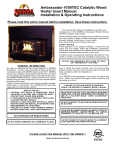
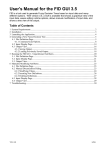
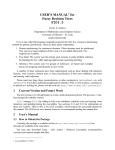
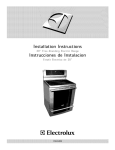
![AudioBox AB64 ABEdit Software User Manual [PDF Format]](http://vs1.manualzilla.com/store/data/005983205_1-2265185b3c4bf7986bc4222e13230c75-150x150.png)
